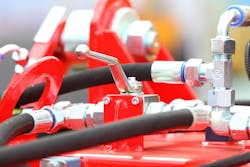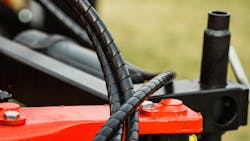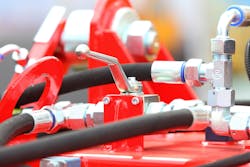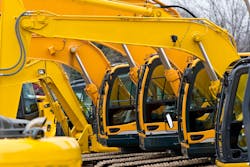Hydraulics is the segment of fluid power which typically uses pressurized oil to transmit power from one point to another, whereas pneumatic systems use gas.
Pascal’s Law provides one of the basic laws of fluid power which essentially states that pressurized fluid in a contained body acts equally in all directions. The basic principle of this law and how it is applied in fluid power is outlined in the Power & Motion article “Chapter 1: Fundamentals of Fluid Power”:
Oil from a pump flows into a cylinder that is lifting a load. The resistance of the load causes pressure to build inside the cylinder until the load starts moving. While the load is in motion, pressure in the entire circuit stays nearly constant. The pressurized oil is trying to get out of the pump, pipe, and cylinder, but these mechanisms are strong enough to contain the fluid. When pressure against the piston area becomes high enough to overcome the load resistance, the oil forces the load to move upward. Understanding Pascal's Law makes it easy to see how all hydraulic and pneumatic circuits function.
While hydraulics and pneumatics each offer unique attributes, it is important to understand the requirements of an application to determine the best solution to use.
Why Choose Hydraulics?
In general, hydraulics is the preferred choice for higher force applications due to the higher power density they provide. Hydraulics typically come into play when needing to move something that weighs several hundred pounds or several tons said Jon Jensen (no relation to author), CFPPS, CFPECS & CFPAI, Industry Projects Manager – Energy at SMC Corporation of America in an interview with Power & Motion.
He went on to explain that because the fluid does not compress in a hydraulic system, heavier objects can be moved with greater efficiency and control than with pneumatics. “It is usually a matter of loads and speeds [as well as] control that would dictate” which technology to use he said.
In addition, hydraulics is able to provide high power density in a small package. This gives hydraulics an advantage over pneumatics and other power transmission technologies in many applications.
Heavy-duty mobile machinery such as construction equipment is a key application in which hydraulic systems are utilized. Hydraulics are beneficial in heavy machinery because of the power density provided and the ability to transfer that power through hoses or other components to move parts of a machine such as the boom and bucket of an excavator.
Hydraulic systems can also be used in industrial equipment in manufacturing facilities, offshore equipment and are found in a range of other applications in which a large amount of power density or force is necessary.
Consider the Pros and Cons
Like any technology, hydraulics has its benefits and challenges which makes it vital to understand what they are and how they could impact system designs as well as end-use customers.
The cost and complexity of hydraulic systems is one of their potential cons said Jensen. There are more components to install and maintain over the life of a machine into which the system is integrated. This includes the system and the oil which flows through it.
Jensen noted each machine using a hydraulic system has its own motors and pumps to monitor and maintain whereas pneumatic systems can typically be run off a single, centralized compressor.
However, many industry professionals consider hydraulics easier to maintain because there are fewer moving parts compared to other technologies. This equates to less wear and tear of components. And when a component does need repair or replacing, it is often relatively easy to do so, depending on the design of the system.
The use of oil is considered among the disadvantages associated with hydraulics due to the potential for leakage. It is generally a matter of when not if a hydraulic system will leak said Ryan Klemetson, Business Development Manager at Tolomatic, during a webinar hosted by the company discussing electromechanical components as an alternative to hydraulics.
Companies continue to look for methods to overcome this, such as new sealing solutions and use of other technologies when it makes sense like electric actuation. Development of oils which are safer for the environment or use in sensitive applications such as food production continue to progress as well.
Because of the potential for leakage from a hydraulic system, designers should be sure to take into consideration the environment in which the system will be utilized.
Efficiency is another challenge area for hydraulics. A substantial amount of power is typically lost during the energy conversion process, reducing a system’s efficiency. Many manufacturers are working to improve efficiency, especially as it has become a more important aspect to OEMs and their customers.
The shift toward electrification is also necessitating efficiency improvements while simultaneously aiding the ability to achieve them through the incorporation of more electronics. Electrohydraulic solutions combining hydraulics and electronics are enabling more precision within systems and the ability to better manage pressure and flow so power is delivered when and where necessary.
Hydraulics are Here to Stay
General industry consensus is there will always be a need for hydraulics due to the power density they can provide. But like many other technologies, they will also continue to evolve to meet ever-changing customer and industry needs.
With the move toward electrification, there will be opportunities to rethink hydraulic component and system designs which will enable improvements in efficiency as well as the potential for a reduction in the number of parts required and system complexity.
WATCH MORE: Hydraulic Improvements Achieved in Wheel Loader Electrification Project
Integration of sensors and software are bringing new opportunities as well. With sensors and software, more precision can be achieved through use of algorithms to provide more accurate performance as well as the ability to add new functionalities. All of this can help further improve efficiency and overall system performance.
Use of sensors and software also enables performance data to be collected which can aid with maintenance planning and future product developments. Better monitoring of components in a hydraulic system makes it easier to see when they may actually need maintenance instead of following a set schedule which can benefit an end user’s time and costs by not making repairs until necessary.
WATCH MORE: Unleashing the Power of Hydraulics
While there are some applications in which hydraulics are being replaced by electromechanical solutions or pure electric systems, there will continue to be a need for hydraulic components and systems in many others. Understanding the application requirements and the attributes of hydraulics and other power transmission options will help to ensure the right solution is utilized.
This article is part of Power & Motion's Fundamentals of Fluid Power: Hydraulics ebook; download the full guide to learn about the latest technologies and design methods for developing modern hydraulic systems.
About the Author
Sara Jensen
Executive Editor, Power & Motion
Sara Jensen is executive editor of Power & Motion, directing expanded coverage into the modern fluid power space, as well as mechatronic and smart technologies. She has over 15 years of publishing experience. Prior to Power & Motion she spent 11 years with a trade publication for engineers of heavy-duty equipment, the last 3 of which were as the editor and brand lead. Over the course of her time in the B2B industry, Sara has gained an extensive knowledge of various heavy-duty equipment industries — including construction, agriculture, mining and on-road trucks —along with the systems and market trends which impact them such as fluid power and electronic motion control technologies.
You can follow Sara and Power & Motion via the following social media handles:
X (formerly Twitter): @TechnlgyEditor and @PowerMotionTech
LinkedIn: @SaraJensen and @Power&Motion
Facebook: @PowerMotionTech




